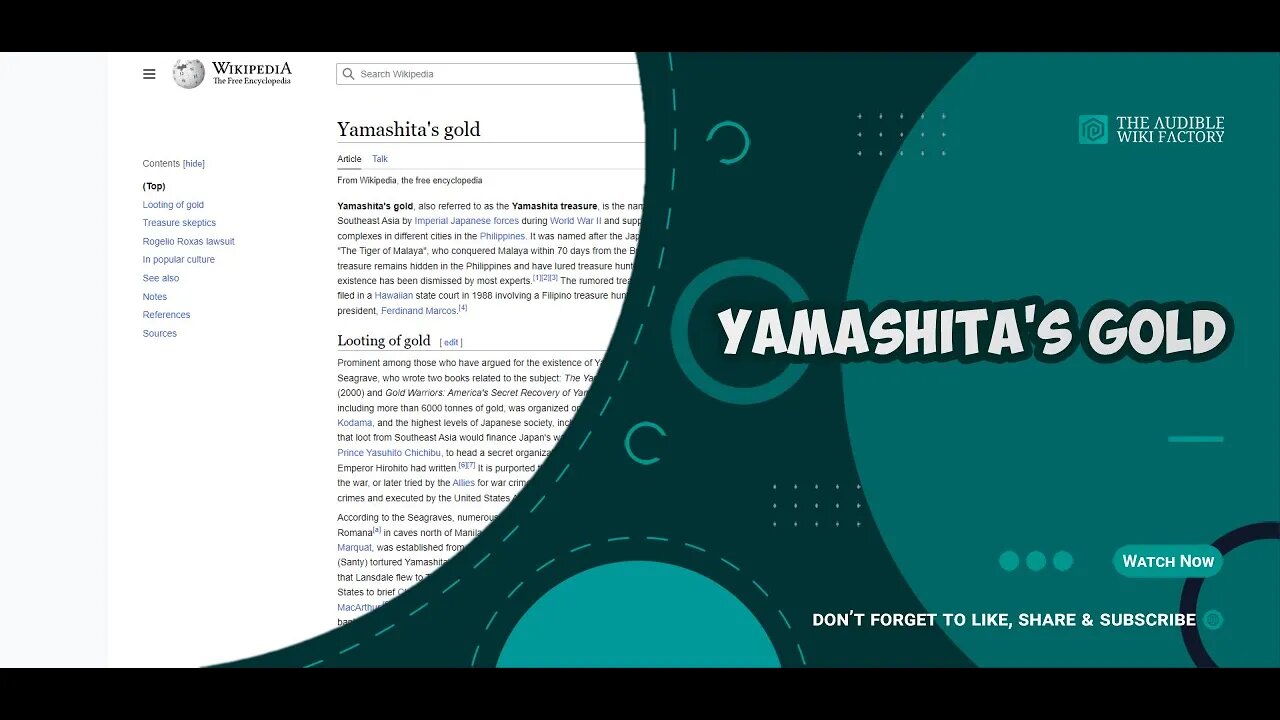Premium Only Content

Yamashita's gold, also referred to as the Yamashita treasure, is the name given to the alleged
Yamashita's gold, also referred to as the Yamashita treasure, is the name given to the alleged war loot stolen in Southeast Asia by Imperial Japanese forces during World War II and supposedly hidden in caves, tunnels, or underground complexes in different cities in the Philippines. It was named after the Japanese general Tomoyuki Yamashita, dubbed as "The Tiger of Malaya", who conquered Malaya within 70 days from the British. Though there are accounts that claim the treasure remains hidden in the Philippines and have lured treasure hunters from around the world for over 50 years, its existence has been dismissed by most experts. The rumored treasure was the subject of a complex lawsuit that was filed in a Hawaiian state court in 1988 involving a Filipino treasure hunter, Rogelio Roxas, and the former Philippine president, Ferdinand Marcos.
LOOTING OF GOLD
Prominent among those who have argued for the existence of Yamashita's gold are Sterling Seagrave and his wife Peggy Seagrave, who wrote two books related to the subject: The Yamato Dynasty: The Secret History of Japan's Imperial Family (2000) and Gold Warriors: America's Secret Recovery of Yamashita's Gold (2003). The Seagraves contend that looting, including more than 6000 tonnes of gold, was organized on a massive scale, by both yakuza gangsters such as Yoshio Kodama, and the highest levels of Japanese society, including Emperor Hirohito. The Japanese government intended that loot from Southeast Asia would finance Japan's war effort. The Seagraves allege that Hirohito appointed his brother, Prince Yasuhito Chichibu, to head a secret organization named Kin no yuri (金の百合, "Golden Lily"), after a poem that the Emperor Hirohito had written. It is purported that many of those who knew the locations of the loot were killed during the war, or later tried by the Allies for war crimes and executed or incarcerated. Yamashita himself was convicted of war crimes and executed by the United States Army on February 23, 1946, in Los Baños, Laguna, the Philippines.
According to the Seagraves, numerous Golden Lily vaults were found by Edward Lansdale and Severino Garcia Diaz Santa Romana in caves north of Manila in the high valleys and the 'M-Fund [ja]', which was named after Major General William Marquat, was established from Santa Romano and Lansdale's work. Sterling Seagrave alleged that Santa Romana (Santy) tortured Yamashita's driver Major Kojima Kashii to obtain the probable locations of the loot. The Seagraves wrote that Lansdale flew to Tokyo and briefed MacArthur and his Chief of Intelligence Charles Willoughby, later flew to the United States to brief Clark Clifford and returned with Robert Anderson to inspect several caves in Philippines with Douglas MacArthur. More than 170 tunnels and caves were found. Ray Cline believes that both Robert Anderson and Paul Helliwell created 176 "black gold" banking accounts in 42 countries after moving the loot by ship to support future United States operations.
The stolen property reportedly included many different kinds of valuables looted from banks, depositories, other commercial premises, museums, private homes, and religious buildings. It takes its name from General Tomoyuki Yamashita, who assumed command of the Japanese forces in the Philippines in 1944.
According to various accounts, the loot was initially concentrated in Singapore, and later transported to the Philippines. The Japanese hoped to ship the treasure from the Philippines to the Japanese Home Islands after the war ended. As the War in the Pacific progressed, United States Navy submarines and Allied warplanes inflicted increasingly heavy sinkings of Japanese merchant shipping. Some of the ships carrying the war booty back to Japan were sunk in combat.
The Seagraves...
LINK TO ARTICLE: http://en.wikipedia.org/wiki/Yamashita's_gold
TAGS: Yamashita's gold, Treasure troves of Asia, Philippines–United States relations, Philippines in World War II, Japan–Philippines relations, Japanese urban legends, Gold standard
#GeneralKnowledge #AudibleWikiFactory #Audible #Wikipedia #Yamashita'sgold
-
 34:34
34:34
The Audible Wiki Factory
1 year agoSaint Patrick's Day, or the Feast of Saint Patrick, is a religious and cultural holiday held on
778 -
 1:20:47
1:20:47
Redacted News
2 hours agoMexico CAVES to Trump over tariffs, USAID Shutdown, & Zelensky loses $200 billion | Redacted Live
77.1K175 -
 LIVE
LIVE
The Amber May Show
1 day agoUSAID | Where Is All The Money Going | IRS Spying On Our Bank Accounts | Sam Anthony
197 watching -
 LIVE
LIVE
Dad Dojo Podcast
1 day agoEP18: NEW YEAR, NEW COLONOSCOPY
71 watching -
 1:54:36
1:54:36
Revenge of the Cis
3 hours agoEpisode 1439: Holy Guacamole
39.7K4 -
 1:01:50
1:01:50
In The Litter Box w/ Jewels & Catturd
1 day ago1 TRILLION! | In the Litter Box w/ Jewels & Catturd – Ep. 733 – 2/3/2025
51.3K31 -
 1:38:44
1:38:44
The Quartering
5 hours agoTrump's Tariffs Already Work, Blackhawk Pilot Coverup, DNC Makes Insane David Hogg Appointment
81.1K77 -
 LIVE
LIVE
Dr Disrespect
7 hours ago🔴LIVE - DR DISRESPECT - TARKOV - ZERO TO HERO RAIDS ONLY
3,181 watching -
 1:13:51
1:13:51
Candace Show Podcast
5 hours agoEXCLUSIVE! Did Ryan Reynolds Extort Hollywood Execs? | Candace Ep 143
112K135 -
 2:01:42
2:01:42
Darkhorse Podcast
5 hours agoA Germ of Truth: The 263rd Evolutionary Lens with Bret Weinstein and Heather Heying
33.4K10